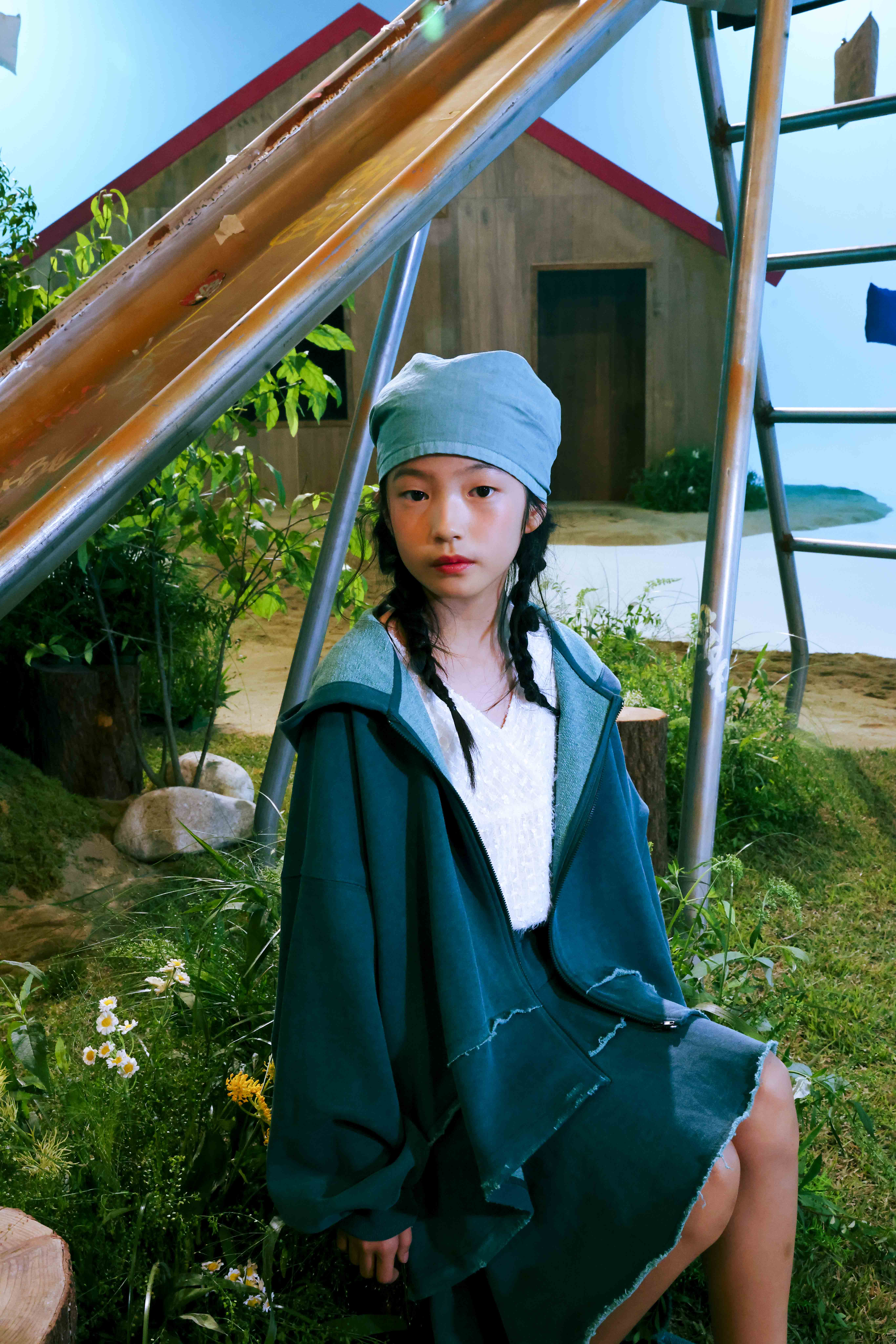The Hollywood DMV seems as appropriate a place as any to draft an article about Jon Rafman. Imagery from his searing 2017 video piece “Poor Magic” keeps looping through my head. _Trapped in this shadow world, my mind eats itself_, the narrator intones. Seemingly desperate computer-generated crowds sprint mindlessly toward a brick wall and collapse on impact into a mounting pile, run off a cliff like lemmings, and charge towards the center of a field where an enormous spinning bar flings them into space. What’s most disturbing is the lack of agency they demonstrate. They’ve been programmed to obliterate themselves.
The DMV queue doesn’t seem to move. We’re standing in the sun against a brick wall, the line snaking outside. A crowd of numbered penitents hurling ourselves ineffectually at the bureaucracy. A man has been shouting about the Big One for thirty-five minutes, between honestly funny riffs on life as a black man in America, fury at Police Chief Charlie Beck, and tossed off threats of violence. He tells me that he ought to whoop my ass and pick my pockets. Then he apologizes, says it’s a ”transference of aggression”: the outrages visited upon him by the DMV and the LAPD are now being directed at me. That’s a good observation, I think. And then he threatens to whoop my ass again. A woman just behind him starts singing Amy Winehouse at full volume. She has a nice voice. Hits most of the notes. Two cars crash next to us. Pretty bad. “I ain’t even mad, because when the ground starts shaking, you’ll all be begging for my help,” the man screams. Is this Rafmania?
[POOR MAGIC, 2017](https://vimeo.com/206170680) from [jonrafman](https://vimeo.com/jonrafman) on [Vimeo](https://vimeo.com).
Good art does that. It articulates something you didn’t yet have an image for, helps explain yourself to yourself. “I investigate subjectivity, that is, what hyper-accelerated contemporary existence does to the psyche,” Rafman tells me. In this niche, he’s among the best. He distills into compelling imagery the vague unease that our “accelerated contemporary existence” often inflicts upon us, as potently as Munch captured a more generalized anxiety. To this day when I feel particularly overwhelmed, or mortified by my own behavior, I’ll sometimes clasp my hands to my face and picture “The Scream.” In my mind that scream is an unvocalized noise louder than anything you can imagine; louder than sound could ever be, because it’s in your own head. My favorite description of the image is from Philip K. Dick in Do Androids Dream of Electric Sheep? (like good art, good writing takes a familiar but unplaceable feeling and crystallizes it in language):
The painting showed a hairless, oppressed creature with a head like an inverted pear, its hands clapped in horror to its ears, its mouth open in a vast, soundless scream. Twisted ripples of the creature’s torment, echoes of its cry, flooded out into the air surrounding it; the man or woman, whichever it was, had become contained by its own howl. It had covered its ears against its own sound. The creature stood on a bridge and no one else was present; the creature screamed in isolation. Cut off by—or despite—its outcry.
“Poor Magic” is my personal favorite, but the ongoing “Dream Journal” series is equally fantastic for planting visions in your imagination that you wouldn’t or couldn’t have ever dreamed up yourself: a baby’s head atop what look like goat’s legs running through a field of impaled figures. A face where a woman’s crotch should be, spitting milk. A demon pulling a snake from a boy’s mouth.
[excerpt from Dream Journal (2015 - 2016)](https://vimeo.com/179476655) from [jonrafman](https://vimeo.com/jonrafman) on [Vimeo](https://vimeo.com).
It’s both disturbing and funny. He eloquently captures the fluid logic of dreams, as well as a particular dysphoria that resembles the feel of endless hours spent crawling through content on the Internet, a brain exhausted and saturated with data and porn and violence and news and noise.
Rafman is one of the few artists that have successfully created meaningful work from the raw material of a life lived online. He’s the kid who spent way too much time on the family computer instead of outside with his friends, but then managed to take that experience and transform it into vital art. But what does it mean to be “vital” in an ephemeral age? I ask him if he thinks the retro web 1.0 feel of much of his work, that uncanny Y2K-era computer graphics aesthetic familiar to fans of _The Sims_, could be as timeless a medium as paint, still resonant after 50 years, or if it might suffer from being too readily pinned to a specific era:
It’s impossible to know what’s going to be relevant in a year, let alone a lifetime from now. This makes me think of a recent recollection I had of a Multi-User Dungeon (MUD) game I used to play in the mid-90s called Punctured Sky. PS (we called it PS on the boards) was a real-time text-based RPG with occasional ASCII graphics. I would log in every day after school and play for 4-8 hours. Recently, I wanted to revisit the game for a project, but I couldn’t find any mention of it anywhere on the internet. So I posted on a retro online RPGs subreddit to see if anyone had any Punctured Sky memories.
Instantly I got a series of replies. One user posted that they recalled how obsessed they too were with Punctured Sky. I was thrilled to see that I was not alone. The thread soon exploded with reminiscences of the game. Then I became curious about why my mom let me play this game every day for hours on end. One Sunday we were eating brunch at our favorite Jewish delicatessen, and I asked my mom why she let me play this game so much—after all, she was quite strict about how much time I spent on the computer. She said that she had always wondered why I’d sit in front of the computer after school, staring at the Windows 95 screensaver for hours. She thought it was bizarre, but would let me be, figuring that I had just been lost in thought, decompressing after a long day at Hebrew school... Anyway, it’s hard to remember the truth about the past, let alone know what the future holds...
That’s hardly an answer to the question, but it is revealing, and it captures the associative flow seen in his work, reminiscent of the link- to-link-to-link-to-link information cascade of a wasted evening spent surfing the web. 2013’s “Still Life (Betamale)” is a particularly visceral look at this content deluge, and the warping effects it can have on the already marginilized. Rafman drags us through the ruins of lives that have dissolved into the screen—filthy computer keyboards covered in chip crumbs and cigarette ash, windowless bedrooms (really no more than a mattress on the floor and a computer desk) cluttered with soda cans and takeout bags. I’m reminded of those stories that pop up every few years: a teen has a heart attack after a marathon gaming session, a child starves to death because her parents were too immersed in their online life. In between these morbid, revolting tableaus we’re presented with rapid-fire flashes of imagery from the dregs of fetish forums— “furries” tied up on a bedroom floor or drowning in quicksand, violent hentai—and of “betamales” (men who possess none of the characteristics of what they claim are “alphamales”).
[STILL LIFE (BETAMALE), 2013](https://vimeo.com/75534042) from [jonrafman](https://vimeo.com/jonrafman) on [Vimeo](https://vimeo.com).
The effect is a portrait of a person being totally overwhelmed by their own indulgence, an identity that has been subsumed by the content it accumulates. But there’s a sense of empathy in Rafman’s approach, and even a quasi-religious sublimity in the sheer volume of content and its power over us, and in the way he evokes all-consuming obsession. The substrate in which our obsessions express themselves may have changed in alarming ways, he seems to be saying, but obsession is as old as humanity itself.
I ask Rafman about how the fracturing and displacing of identity in the digital age is represented in his work. Are we even separable from our digital selves? If we spend as much time on the internet as we do off of it, where do we actually live?
Our digital lives and lived experience are so intertwined that it is hard to formulate that question: what are the sources of our being, our lived experience, what comes from where, where or who are we? The dichotomy between digital and real life has collapsed in large parts of the world. I’m interested in finding ways to represent this collapse. There is less and less of sense or meaning in what confronts us, and it is harder and harder to organize what is being presented to us. My recent videos try to capture how much the overload of digital content has infiltrated every aspect of our lives and how it shapes our perception.
Sometimes I wonder, do we even have shared experiences anymore given the differences in the media we consume and the different virtual lives we all lead? Do we have a single reality to which we all refer? The algorithms that recreate or define our world, the digital content void of any ethical base, enters our very being, our very body and can refer us back to a world without a social contract. What will happen to our humanity? When digital content created by those whose agenda is problematic is constantly present, what is governing our actions, do we even have any control becomes very puzzling. Where is the human being in all this?
That last question, with regards to the artist himself, isn’t easy to answer. Rafman’s presence in his work is enigmatic—he prefers to refract his perspective through the strange nameless characters that narrate his films. Biographical details are equally sparse. The 36-year-old artist was born in Montreal, where he still lives and works. He studied Philosophy and Literature at the local McGill University before he pursued his MFA at the Chicago Institute of Art. He first drew attention with his “Nine Eyes of Google Streetview” project. Begun in 2008, “Nine Eyes” is an ongoing exploration of photography in the age of mass, autonomous image making. Rafman re-photographs startling images from Google’s massive database—car crashes, animals on the run, children with guns drawn—which are framed with the unsettling disregard of an algorithm. The photographs existed in some sense already, but until Rafman found them and presented them as standalone images, they might as well have not existed at all, languishing unseen in the galaxy of data that Google has accumulated.


Jon Rafman. Video still from "View of Harbor" (2018). Virtual reality headsets and 3D simulation. Color, sound. Approximately 8:00 minutes. Virtual reality developed by studio Samuel Walker. Courtesy of the artist.
As for what’s next for an artist who has spent his career probing the bleeding edge of culture, Rafman is increasingly incorporating new technological developments into his work, particularly VR, as seen in this year’s “View of Harbor” at Boston’s Institute of Contemporary Art. When you first place the headset on your head, the virtual reality mirrors the one you left—you see the ICA museum architecture framing a view of the harbor, “collapsing real and virtual space.” However, the scene quickly becomes a hallucinogenic nightmare—a tidal wave rises from the harbor, and soon the viewer is immersed in an apocalypse of writhing bodies and tunneling darkness. Rafman has increasingly moved beyond cataloging or articulating the contemporary experience to peering forward and creating it. His latest work doesn’t rely on found or appropriated content—it invents images that reflect not just our digital dysphoria, but the deeper darkness of a world and culture on the brink, where meaning or subjectivity is increasingly replaced by automation and mass-data, and where our identities become inseparable from the ceaseless flow of information pouring from our devices. If our world is not post- human already, Rafman suggests, it soon will be.
* * *
Written by Sid Feddema
 
Jon Rafman. Video still from "View of Harbor" (2018). Virtual reality headsets and 3D simulation. Color, sound. Approximately 8:00 minutes. Virtual reality developed by studio Samuel Walker. Courtesy of the artist.
As for what’s next for an artist who has spent his career probing the bleeding edge of culture, Rafman is increasingly incorporating new technological developments into his work, particularly VR, as seen in this year’s “View of Harbor” at Boston’s Institute of Contemporary Art. When you first place the headset on your head, the virtual reality mirrors the one you left—you see the ICA museum architecture framing a view of the harbor, “collapsing real and virtual space.” However, the scene quickly becomes a hallucinogenic nightmare—a tidal wave rises from the harbor, and soon the viewer is immersed in an apocalypse of writhing bodies and tunneling darkness. Rafman has increasingly moved beyond cataloging or articulating the contemporary experience to peering forward and creating it. His latest work doesn’t rely on found or appropriated content—it invents images that reflect not just our digital dysphoria, but the deeper darkness of a world and culture on the brink, where meaning or subjectivity is increasingly replaced by automation and mass-data, and where our identities become inseparable from the ceaseless flow of information pouring from our devices. If our world is not post- human already, Rafman suggests, it soon will be.
* * *
Written by Sid Feddema

Jon Rafman. Video still from "View of Harbor" (2018). Virtual reality headsets and 3D simulation. Color, sound. Approximately 8:00 minutes. Virtual reality developed by studio Samuel Walker. Courtesy of the artist.
As for what’s next for an artist who has spent his career probing the bleeding edge of culture, Rafman is increasingly incorporating new technological developments into his work, particularly VR, as seen in this year’s “View of Harbor” at Boston’s Institute of Contemporary Art. When you first place the headset on your head, the virtual reality mirrors the one you left—you see the ICA museum architecture framing a view of the harbor, “collapsing real and virtual space.” However, the scene quickly becomes a hallucinogenic nightmare—a tidal wave rises from the harbor, and soon the viewer is immersed in an apocalypse of writhing bodies and tunneling darkness. Rafman has increasingly moved beyond cataloging or articulating the contemporary experience to peering forward and creating it. His latest work doesn’t rely on found or appropriated content—it invents images that reflect not just our digital dysphoria, but the deeper darkness of a world and culture on the brink, where meaning or subjectivity is increasingly replaced by automation and mass-data, and where our identities become inseparable from the ceaseless flow of information pouring from our devices. If our world is not post- human already, Rafman suggests, it soon will be.
* * *
Written by Sid Feddema


















